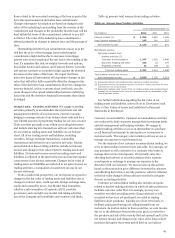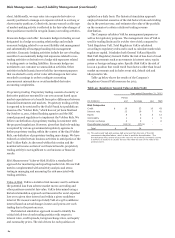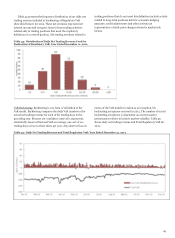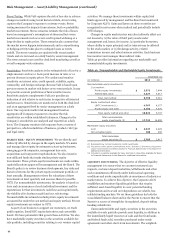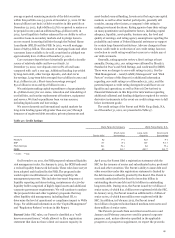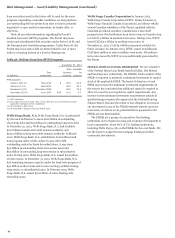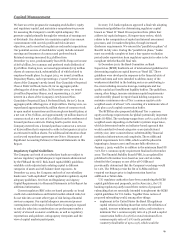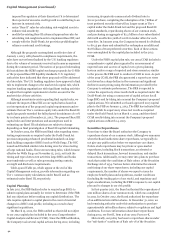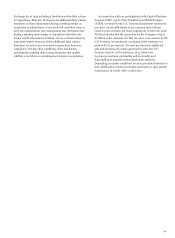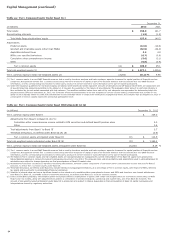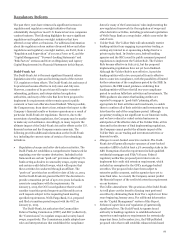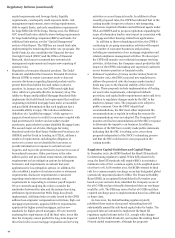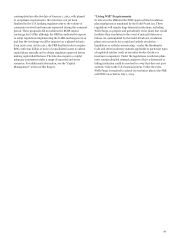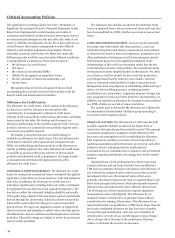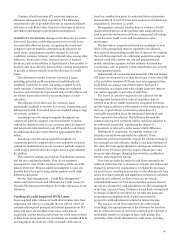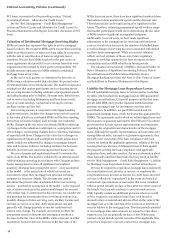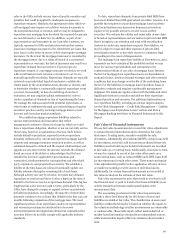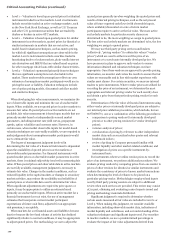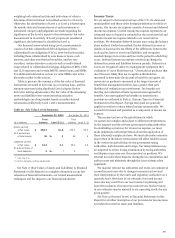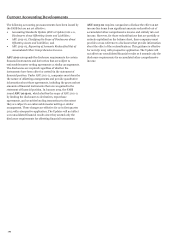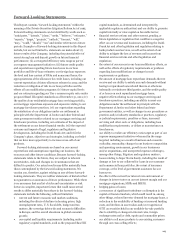Wells Fargo 2012 Annual Report Download - page 95
Download and view the complete annual report
Please find page 95 of the 2012 Wells Fargo annual report below. You can navigate through the pages in the report by either clicking on the pages listed below, or by using the keyword search tool below to find specific information within the annual report.
Regulatory Reform
The past three years have witnessed a significant increase in
regulation and regulatory oversight initiatives that may
substantially change how most U.S. financial services companies
conduct business. The following highlights the more significant
regulations and regulatory oversight initiatives that have
affected or may affect our business. For additional information
about the regulatory reform matters discussed below and other
regulations and regulatory oversight matters, see Part I, Item 1
“Regulation and Supervision” of our 2012 Form 10-K, and the
“Capital Management,” “Forward-Looking Statements” and
“Risk Factors” sections and Note 26 (Regulatory and Agency
Capital Requirements) to Financial Statements in this Report.
Dodd-Frank Act
The Dodd-Frank Act is the most significant financial reform
legislation since the 1930s and is driving much of the current
U.S. regulatory reform efforts. The Dodd-Frank Act and many of
its provisions became effective in July 2010 and July 2011.
However, a number of its provisions still require extensive
rulemaking, guidance, and interpretation by regulatory
authorities, and many of the rules that have been proposed to
implement its requirements either remain open for public
comment or have not otherwise been finalized. Where possible,
the Company may, from time to time, estimate the impact to the
Company’s financial results or business operations as a result of
particular Dodd-Frank Act regulations. However, due to the
uncertainty of pending regulations, the Company may be unable
to make any such estimates. Accordingly, in many respects the
ultimate impact of the Dodd-Frank Act and its effects on the U.S.
financial system and the Company remain uncertain. The
following provides additional information on the Dodd-Frank
Act, including the current status of certain of its rulemaking
initiatives.
x Regulation of swaps and other derivatives activities. The
Dodd-Frank Act establishes a comprehensive framework for
regulating over-the-counter derivatives. Included in this
framework are certain “push-out” provisions affecting U.S.
banks acting as dealers in commodity swaps, equity swaps
and certain credit default swaps, which will require that
these activities be conducted through an affiliate. The
“push-out” provision has an effective date of July 21, 2013,
but the Dodd-Frank Act granted the OCC the discretion to
provide a transition period of up to two years for banks to
come into compliance with the requirements. On
January 3, 2013, the OCC issued guidance that it would
consider transition period requests and favorably act on
such requests subject to the requesting bank meeting
specified requirements. Wells Fargo Bank, N.A. prepared
and filed a transition period request with the OCC on
January 31, 2013.
The Dodd-Frank Act authorizes the Commodities
Futures Trading Commission (CFTC) and SEC (collectively,
the “Commissions”) to regulate swaps and security-based
swaps, respectively. The Commissions jointly adopted new
rules and interpretations that established the compliance
dates for many of the Commissions’ rules implementing the
new regulatory framework for the regulation of swaps and
other derivative activities, including provisional registration
of Wells Fargo Bank as a swap dealer, which occurred at the
end of 2012.
x Volcker Rule. The Volcker Rule will substantially restrict
banking entities from engaging in proprietary trading or
owning any interest in or sponsoring a hedge fund or a
private equity fund. In October 2011, federal banking
agencies and the SEC issued for public comment proposed
regulations to implement the Volcker Rule. The Volcker
Rule became effective in July 2012, but the proposed
implementing regulations have not yet been finalized.
Although the Volcker Rule is now effective, it provides
banking entities with a two year period from its effective
date to come into compliance, with the possibility of limited
further extensions of the compliance period by the FRB. In
April 2012, the FRB issued guidance confirming that
banking entities will have the full two-year compliance
period to conform fully their activities and investments. The
FRB’s guidance also states that banking entities are
expected to engage in “good-faith” planning efforts,
appropriate for their activities and investments, to enable
them to conform all of their activities and investments by no
later than the end of the compliance period. Although
proprietary trading is not significant to our financial results,
and we have reduced or exited certain businesses in
anticipation of the effective date of the Volcker Rule, at this
time and in the absence of final implementing regulations,
the Company cannot predict the ultimate impact of the
Volcker Rule on our trading and investment activities or
financial results.
x Changes to asset-backed securities markets. The Dodd-
Frank Act will generally require sponsors of asset-backed
securities (ABS) to hold at least a 5% ownership stake in the
ABS. Exemptions from the requirement include qualified
residential mortgages and FHA/VA loans. Federal
regulatory authorities proposed joint rules in 2011 to
implement this credit risk retention requirement, which
included an exemption for the GSE’s mortgage-backed
securities. The proposed rules have been subject to
extensive public comment, and the agencies have yet to
issue final rules. As a result, the Company cannot predict
the financial impact of the credit risk retention requirement
on our business.
x The Collins Amendment. This provision of the Dodd-Frank
Act will phase out the benefit of issuing trust preferred
securities by eliminating them from Tier 1 capital over three
years beginning January 2013. For additional information
see the “Capital Management” section of this Report.
x Enhanced supervision and regulation of systemically
significant firms. The Dodd-Frank Act grants broad
authority to banking regulators to establish enhanced
supervisory and regulatory requirements for systemically
important firms. In December 2011, the FRB published
proposed rules that would establish enhanced risk-based
93


